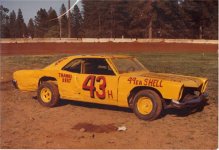Postbaer61
Bluebear
I just noticed it also. Don't know why I never noticed it before. The "C" is missing from the wing registration.
Yes, and the number on the rudder should be 80309 instead of 30809 , shouldn't it be?
There seems to be an uptick in Political comments in recent months. Those of us who are long time members of the site know that Political and Religious content has been banned for years. Nothing has changed. Please leave all political and religious comments out of the forums.
If you recently joined the forums you were not presented with this restriction in the terms of service. This was due to a conversion error when we went from vBulletin to Xenforo. We have updated our terms of service to reflect these corrections.
Please note any post refering to a politician will be considered political even if it is intended to be humor. Our experience is these topics have a way of dividing the forums and causing deep resentment among members. It is a poison to the community. We appreciate compliance with the rules.
The Staff of SOH
I just noticed it also. Don't know why I never noticed it before. The "C" is missing from the wing registration.
Yes, and the number on the rudder should be 80309 instead of 30809 , shouldn't it be?
oh, dear, I feel really stupid now...


oh, dear, I feel really stupid now...

 jk2645 by JanKees Blom, on Flickr
jk2645 by JanKees Blom, on Flickr Clip_45 by JanKees Blom, on Flickr
Clip_45 by JanKees Blom, on Flickr jk2646 by JanKees Blom, on Flickr
jk2646 by JanKees Blom, on Flickr jk2666 by JanKees Blom, on Flickr
jk2666 by JanKees Blom, on Flickr jk2676 by JanKees Blom, on Flickr
jk2676 by JanKees Blom, on Flickr jk2681 by JanKees Blom, on Flickr
jk2681 by JanKees Blom, on FlickrLook what I just uploaded on flightsim.to:
jk2600 by JanKees Blom, on Flickr
jk2597 by JanKees Blom, on Flickr
jk2601 by JanKees Blom, on Flickr
Into the blue has a nice asessment. It's not a study sim, but a very good $15 aircraft. I agree with his assessment of the "bounce" on landing. Yet to get it to settle smoothly on any surface.
https://www.youtube.com/watch?v=3AoOuetXcsU
 jk2751 by JanKees Blom, on Flickr
jk2751 by JanKees Blom, on Flickr jk2697 by JanKees Blom, on Flickr
jk2697 by JanKees Blom, on Flickr jk2731 by JanKees Blom, on Flickr
jk2731 by JanKees Blom, on Flickr jk2729 by JanKees Blom, on Flickr
jk2729 by JanKees Blom, on Flickr jk2695 by JanKees Blom, on Flickr
jk2695 by JanKees Blom, on Flickr jk2759 by JanKees Blom, on Flickr
jk2759 by JanKees Blom, on Flickr
You should post this to his Youtube comments. Feedback is always appreciated.I don't consider it a nice assessment, I found it rushed, lazy, and worthless to me as a potential buyer. There is no intelligent review of the flight model. At one point in the video he says the model has no documentation, so he's just guessing at the flight performance. He could have found an online Staggerwing POH in 5 minutes, tried to fly it by the book and see if it performs properly. That's the kind of thing that would enable you to pick up the kind of subtle issues that he has been missing lately such as, for instance, a P-51 with a 4,000 hp engine that is almost 100 mph too fast. Nope, apparently it's more important to get a video out the same day the plane is issued, I guess that gets you the most clicks and revenue. He's doing this a lot now, and I've lost interest in his vids. And I still don't know whether the thing flies right. Hopefully someone like EchoMikeDelta will do a proper review in a few weeks. I can wait.August
 jk2906 by JanKees Blom, on Flickr
jk2906 by JanKees Blom, on Flickr jk2871 by JanKees Blom, on Flickr
jk2871 by JanKees Blom, on Flickr jk2847 by JanKees Blom, on Flickr
jk2847 by JanKees Blom, on Flickrand another batch of paints:
jk2906 by JanKees Blom, on Flickr
jk2871 by JanKees Blom, on Flickr
jk2847 by JanKees Blom, on Flickr
